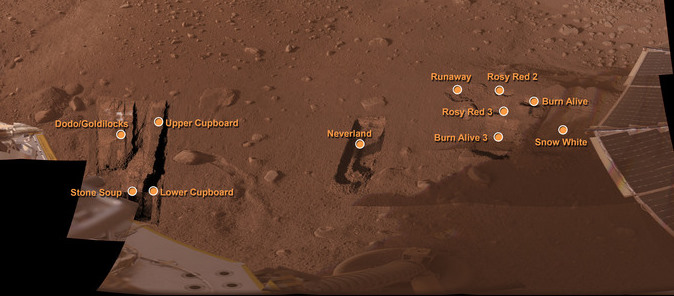[/caption]
Scientists and engineers from NASA’s Phoenix Mars Lander continue with digging operations around the lander with the spacecraft’s robotic arm. They are looking for new materials to analyze and are examining the soil and ice subsurface structure. “We expect to use the robotic arm heavily over the next several weeks, delivering samples to our instruments and examining trench floors and walls to continue to search for evidence of lateral and vertical variations in soil and ice structures,” said Ray Arvidson, Phoenix’s “dig czar,” from Washington University in St. Louis. New trenches opened recently and shown in the image here include the “Burn Alive 3” trench in the eastern portion of the arm’s reachable workspace.
The team is excavating one side of this trench down to the ice layer and plans to leave about 1 centimeter (0.4 inch) of soil above the ice on the other side. From this intermediate depth is where scientists hope to test a sample of soil in Phoenix’s Thermal and Evolved Gas Analyzer (TEGA).
Near the western end of the arm’s workspace, the team plans to dig as deep as possible in the “Cupboard” excavation area to study properties of the soil and ice in one of the polygon trough areas. Like on Earth, the polygon patterns form in areas of permafrost that goes through cycles of swelling and shrinking as the ground thaws and refreezes.
A sample from the Cupboard area may be delivered to the lander’s wet chemistry lab, part of the Microscopy, Electrochemistry and Conductivity Analyzer (MECA) to test for the presence of salts. In addition, the robotic arm will try to acquire ice-rich soil from “Upper Cupboard” and observe the material in the arm’s scoop to determine whether the sample sublimates. Melting is an indication of the presence of salt. If the sample melts and leaves behind a salty deposit, “Upper Cupboard” would be the location for the next sample for the wet chemistry lab. If no salts are detected, the team would
continue with plans to use the “Stone Soup” trench for acquiring the next wet chemistry lab sample.
If you’re wondering about the interesting names of the different areas, the team names the areas and trenches to make identification easier (instead of saying something like “that trench in the upper left corner of the image taken on Sol 45.”) The names are chosen from various fairy tales and myths.
A change has taken place for the scientists and engineers working with Phoenix. They are now working on Earth time instead of Mars time. This eliminates the constantly transitioning work period as a Mars sol is about 40 minutes longer than an Earth day. Undoubtedly, this has to make their lives much easier, instead of juggling their Earth life and Mars work every day.
Daily activities are being planned for the spacecraft as the lander performs activities that were sent up the previous day. Digging and documenting are done on alternate days to allow the science team time to analyze data and adjust activities accordingly.
In upcoming sols, the team plans to scrape the “Snow White” trench and experiment with acquiring and holding samples in the shade versus the sun. They want to find out if prolonged exposure to sunlight causes the acquired material to stick to the scoop, as has occurred with previous samples.
Source: Phoenix News site


who names these trenches?
LLDIAZ –The scientists and engineers involved with Phoenix name the different features found at the landing site.
I wanna see “candyland” next!
Why do I get the feeling of disappointment among the members in the Phoenix group?
to nedreck :
New unpredictable unknown parameters have emerged ….so they must adjust with what tools they have on Mars right now.
WHEN YOU VISIT NEW PLANETS YOU MUST EXPECT THE UNEXPECTABLE
They are forced to rube-goldberg and to improvise as they go because of this just like Apollo 13…
SOME SCIENTIST geologist or chemist SOMEWHERE IN THE WORLD MAY BE ABLE TO ANALYZE THIS BUT NOT LAYMEN LIKE US.
Maybe digging is not the most sophisticated approach ….but they are stuck with it now.
Future landers from ESA and NASA will have more sophisticated instruments and techniques and will give answers faster.